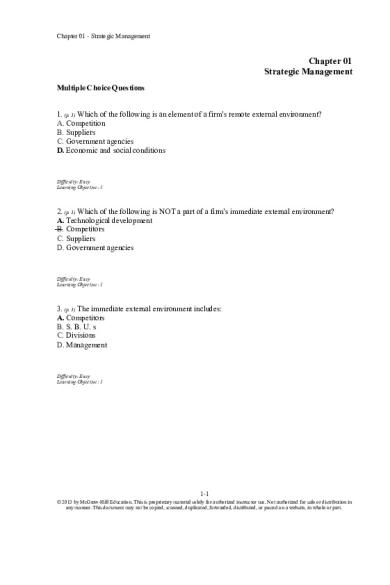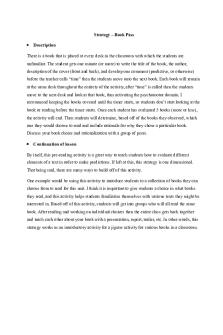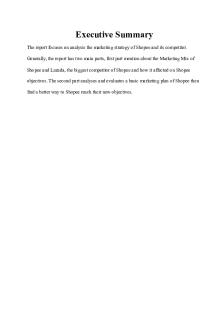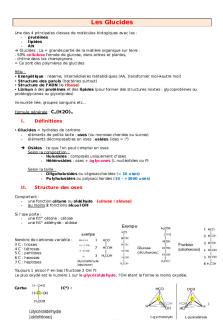Ch001 - Study to pass PDF

| Title | Ch001 - Study to pass |
|---|---|
| Course | Business administration |
| Institution | University of Ghana |
| Pages | 27 |
| File Size | 446.5 KB |
| File Type | |
| Total Downloads | 60 |
| Total Views | 167 |
Summary
Study to pass...
Description
Chapter 01 - Strategic Management
Chapter 01 Strategic Management Multiple Choice Questions 1. (p. 3) Which of the following is an element of a firm's remote external environment? A. Competition B. Suppliers C. Government agencies D. Economic and social conditions
Difficulty: Easy Learning Objective: 1
2. (p. 3) Which of the following is NOT a part of a firm's immediate external environment? A. Technological development B. Competitors C. Suppliers D. Government agencies
Difficulty: Easy Learning Objective: 1
3. (p. 3) The immediate external environment includes: A. Competitors B. S. B. U. s C. Divisions D. Management
Difficulty: Easy Learning Objective: 1
1-1 © 2013 by McGraw-Hill Education. This is proprietary material solely for authorized instructor use. Not authorized for sale or distribution in any manner. This document may not be copied, scanned, duplicated, forwarded, distributed, or posted on a website, in whole or part.
Chapter 01 - Strategic Management
4. (p. 3) The _______ comprises economic and social conditions, political priorities and technological developments, all of which must be anticipated, monitored, assessed and incorporated into the executive's decision making. A. Remote external environment B. Task environment C. Operating environment D. Internal environment
Difficulty: Easy Learning Objective: 1
5. (p. 3) The set of decisions and actions resulting in the formulation and implementation of plans designed to achieve a company's objectives is defined as: A. Strategic policy B. Business policy C. Strategic management D. Tactics
Difficulty: Medium Learning Objective: 2
6. (p. 3) Strategic management compromises nine critical tasks. Which of the following is NOT one of the tasks? A. Development of annual objectives compatible with grand strategies B. Assessment of the company's external environment C. Selection of a particular set of long-term objectives and grand strategies D. Evaluate the success of the strategic process
Difficulty: Medium Learning Objective: 2
1-2 © 2013 by McGraw-Hill Education. This is proprietary material solely for authorized instructor use. Not authorized for sale or distribution in any manner. This document may not be copied, scanned, duplicated, forwarded, distributed, or posted on a website, in whole or part.
Chapter 01 - Strategic Management
7. (p. 4) Strategic management involves the _____, directing, _____ and controlling of a company's strategy-related decisions and actions. A. Financing; marketing B. Planning; financing C. Marketing; planning D. Planning; organizing
Difficulty: Medium Learning Objective: 2
8. (p.4) Large-scale, future-oriented plans, for interacting with the competitive environment to achieve company objectives refers to its A. Strategy B. Goals C. Competitive analysis D. Dynamic policies
Difficulty: Easy Learning Objective: 2
9. (p. 4) A strategy is a company's A. Game plan B. Pricing policy C. Value statement D. Long-term objective
Difficulty: Easy Learning Objective: 2
10. (p. 4) A _____is a company's game plan. A. Strategy B. Pricing policy C. Value statement D. Long-term objective
Difficulty: Easy Learning Objective: 2
1-3 © 2013 by McGraw-Hill Education. This is proprietary material solely for authorized instructor use. Not authorized for sale or distribution in any manner. This document may not be copied, scanned, duplicated, forwarded, distributed, or posted on a website, in whole or part.
Chapter 01 - Strategic Management
11. (p. 4) A(n) _____ reflects a company's awareness of how, when and where is should compete, against whom it should compete and for what purpose it should compete. A. Vision B. Organizational structure C. Strategy D. Long-term objective
Difficulty: Medium Learning Objective: 2
12. (p. 4) A(n) strategy reflects a company's awareness of how, when and where is should ____, against whom it should _____ and for what purpose it should _____. A. cooperate B. ally C. compete D. plan
Difficulty: Medium Learning Objective: 2
13. (p. 4) Strategic issues require which level of management decisions? A. Operative B. Top C. Front-line D. Middle
Difficulty: Easy Learning Objective: 2
1-4 © 2013 by McGraw-Hill Education. This is proprietary material solely for authorized instructor use. Not authorized for sale or distribution in any manner. This document may not be copied, scanned, duplicated, forwarded, distributed, or posted on a website, in whole or part.
Chapter 01 - Strategic Management
14. (p. 5) Strategic decisions ostensibly commit the firm for A. 1-2 years B. The short term C. 3-4 years D. A long time, typically five years Difficulty: Medium Learning Objective: 2
15. (p. 5) Strategic issues require large amounts of the company’s A. strengths B. opportunities C. suppliers D. resources
Difficulty: Medium Learning Objective: 2
16. (p. 4-5) Some business decisions are strategic and therefore deserve strategic management attention. Which of the following is one of the six strategic issue dimensions? A. Requires front-line employee decisions B. Is not likely to have a significant impact on long-term prosperity of the firm C. Necessitates considering factors in the firm's external environment D. Is spontaneous
Difficulty: Medium Learning Objective: 3
1-5 © 2013 by McGraw-Hill Education. This is proprietary material solely for authorized instructor use. Not authorized for sale or distribution in any manner. This document may not be copied, scanned, duplicated, forwarded, distributed, or posted on a website, in whole or part.
Chapter 01 - Strategic Management
17. (p. 5) Which of the following applies to strategic issues? A. Consider only the firm's internal environment B. Are future oriented C. Concern allocation of insignificant amounts of company resources D. Do not have long-term impact on the firm's prosperity
Difficulty: Easy Learning Objective: 3
18. (p. 5) Strategic issues are ____ oriented. A. future B. present C. past D. timelessly
Difficulty: Hard Learning Objective: 3
19. (p. 5) Strategic decisions are based on what managers _____, rather than on what they _____. A. Forecast; know B. React to; anticipate C. Know; forecast D. Compromise with; analyze Difficulty: Hard Learning Objective: 3
1-6 © 2013 by McGraw-Hill Education. This is proprietary material solely for authorized instructor use. Not authorized for sale or distribution in any manner. This document may not be copied, scanned, duplicated, forwarded, distributed, or posted on a website, in whole or part.
Chapter 01 - Strategic Management
20. (p. 5) All businesses exist in a(n) _____ system. A. open B. closed C. insular D. protected
Difficulty: Hard Learning Objective: 3
21. (p. 5) In a turbulent and competitive free enterprise environment, a firm will succeed only if it takes a(n) ____ stance towards change. A. Reactive B. Anti-regulatory or anti-government C. Proactive D. Vision and not mission
Difficulty: Medium Learning Objective: 3
22. (p. 6) General Electric is a multi-business company. It typically would have ____ levels of strategy. A. 5 or more B. 4 C. 3 D. 2 Difficulty: Easy Learning Objective: 4
23. (p. 6) Which level of strategy uses a portfolio approach? A. Business B. Operational C. Corporate D. Functional Difficulty: Easy Learning Objective: 4
1-7 © 2013 by McGraw-Hill Education. This is proprietary material solely for authorized instructor use. Not authorized for sale or distribution in any manner. This document may not be copied, scanned, duplicated, forwarded, distributed, or posted on a website, in whole or part.
Chapter 01 - Strategic Management
24. (p. 6) Which level of strategy is in the middle of the decision-making hierarchy? A. Corporate B. Functional C. Business D. Strategic
Difficulty: Easy Learning Objective: 4
25. (p. 6) Which level of strategy is at the bottom of the decision-making hierarchy? A. Corporate B. Business C. Functional D. Strategic
Difficulty: Easy Learning Objective: 4
26. (p. 6) Which level of strategy is at the top of the decision-making hierarchy? A. Functional B. Business C. Corporate D. Operational
Difficulty: Easy Learning Objective: 4
27. (p. 6) Typically how many strategic decision levels are in the corporate decision-making hierarchy? A. 5 or more B. 4 C. 3 D. 2
Difficulty: Easy Learning Objective: 4
1-8 © 2013 by McGraw-Hill Education. This is proprietary material solely for authorized instructor use. Not authorized for sale or distribution in any manner. This document may not be copied, scanned, duplicated, forwarded, distributed, or posted on a website, in whole or part.
Chapter 01 - Strategic Management
28. (p. 6) To a large extent, attitudes at the corporate level reflect the concerns of A. Stockholders and society at large B. Top managers C. The CEO D. The federal government Difficulty: Medium Learning Objective: 4
29. (p. 6) The top of the decision-making hierarchy comprises all of these EXCEPT A. Board of directors B. Front-line managers C. The CEO D. Administrative officers
Difficulty: Easy Learning Objective: 4
30. (p. 6) In a multi-business firm, ______ -level executives determine the businesses in which the firm should be involved. A. Business B. Functional C. Corporate D. Operative
Difficulty: Medium Learning Objective: 4
31. (p. 6) At Office Supply, Inc., ____ -level managers would be responsible for determining whether the company should be involved in home furnishings or electronic appliance businesses, where as ____ -level managers would be responsible for determining how the firm will compete in the selected product-market arena. A. Business; corporate B. Corporate; functional C. Functional; business D. Corporate; business
Difficulty: Hard Learning Objective: 4
1-9 © 2013 by McGraw-Hill Education. This is proprietary material solely for authorized instructor use. Not authorized for sale or distribution in any manner. This document may not be copied, scanned, duplicated, forwarded, distributed, or posted on a website, in whole or part.
Chapter 01 - Strategic Management
32. (p. 6) In the middle of the decision-making hierarchy is the _____ level. A. Corporate B. Functional C. Business D. Strategic Difficulty: Medium Learning Objective: 4
33. (p. 6) Who determines the basis on which a company can compete in the selected productmarket arena? A. Functional-level strategic managers B. Corporate-level strategic managers C. Business-level strategic managers D. Operational managers supervising operative
Difficulty: Medium Learning Objective: 4
34. (p. 6) Which of these managers tries to identify and secure the most profitable and promising market segment? A. Functional managers B. Corporate managers C. Business managers D. Operative
Difficulty: Medium Learning Objective: 4
35. (p. 6) The functional level of decision making is characterized by: A. The board of directors deriving corporate goals B. Managers of product, geographic and functional areas C. The CEO developing a company profile D. Business managers interpreting the mission into operational objectives
Difficulty: Medium Learning Objective: 4
1-10 © 2013 by McGraw-Hill Education. This is proprietary material solely for authorized instructor use. Not authorized for sale or distribution in any manner. This document may not be copied, scanned, duplicated, forwarded, distributed, or posted on a website, in whole or part.
Chapter 01 - Strategic Management
36. (p. 6) Which strategic level is typically responsible for developing annual objectives and short-term strategies? A. Functional level B. Corporate level C. Business level D. Board of Directors level Difficulty: Medium Learning Objective: 4
37. (p. 6) Which of the following is NOT a level in the decision-making hierarchy of a firm? A. Business B. Corporate C. Operative D. Functional
Difficulty: Medium Learning Objective: 4
38. (p. 6) Functional managers are typically responsible for which of the following? A. Annual objectives B. Tactics C. Corporate goals D. Mission
Difficulty: Medium Learning Objective: 4
39. (p. 7) Whereas corporate and business-level managers center their attention on _____, managers at functional-level center their attention on ____. A. Operational issues; strategic issues B. Doing things right; doing the right things C. Entrepreneurial mode; adaptive mode D. Doing the right things; doing things right
Difficulty: Hard Learning Objective: 4
1-11 © 2013 by McGraw-Hill Education. This is proprietary material solely for authorized instructor use. Not authorized for sale or distribution in any manner. This document may not be copied, scanned, duplicated, forwarded, distributed, or posted on a website, in whole or part.
Chapter 01 - Strategic Management
40. (p. 7) Decisions at which level of management tend to be more value-oriented and conceptual? A. Functional B. Corporate C. Operative D. Business Difficulty: Medium Learning Objective: 4
41. (p. 8) Dividend policies are decided at the A. Corporate level B. Business level C. Functional level D. Operational level
Difficulty: Medium Learning Objective: 4
42. (p. 8) Which level of decisions encompasses greater risk, cost and profit potential? A. Business B. Lower echelon C. Corporate D. Functional
Difficulty: Medium Learning Objective: 4
43. (p. 8) Corporate-level decisions are characterized by: A. Decreased risk B. Doing things right C. Short-time horizons D. Greater profit
Difficulty: Hard Learning Objective: 4
1-12 © 2013 by McGraw-Hill Education. This is proprietary material solely for authorized instructor use. Not authorized for sale or distribution in any manner. This document may not be copied, scanned, duplicated, forwarded, distributed, or posted on a website, in whole or part.
Chapter 01 - Strategic Management
44. (p. 8) Decisions concerning plant location, distribution channels, geographic coverage and market segmentation are typically made at: A. The corporate level B. The business level C. The functional level D. The front-line operational level Difficulty: Medium Learning Objective: 4
45. (p. 8) The degree to which participation, responsibility, authority and discretion in decisionmaking are specified is called: A. Informality B. Formality C. Functional tactic D. Dynamic mode
Difficulty: Medium Learning Objective: 4
46. (p. 8) Which one of these forces DOES NOT determine how much formality is needed in strategic management? A. Size B. Country of origin C. Complexity of environment D. Predominant management style
Difficulty: Medium Learning Objective: 4
1-13 © 2013 by McGraw-Hill Education. This is proprietary material solely for authorized instructor use. Not authorized for sale or distribution in any manner. This document may not be copied, scanned, duplicated, forwarded, distributed, or posted on a website, in whole or part.
Chapter 01 - Strategic Management
47. (p. 8) Which of these is usually positively correlated with the cost, comprehensiveness, accuracy and success of planning? A. Greater formality B. Functional structure C. Organizational matrix D. Functional tactics Difficulty: Medium Learning Objective: 4
48. (p. 9) According to Henry Mintzberg, there are ____ modes based upon formality in strategic management. A. 4 B. 2 C. 5 D. 3
Difficulty: Medium Learning Objective: 4
49. (p. 9) According to Henry Mintzberg, very large firms typically use the _____ mode of strategic management. A. Adaptive B. Entrepreneurial C. Informal D. Planning
Difficulty: Medium Learning Objective: 4
50. (p. 9) Henry Mintzberg identified a mode which he associates with medium-sized firms in relatively stable environments. This is referred to as a(n) ____ mode. A. Entrepreneurial B. Adaptive C. Business D. Planning
Difficulty: Medium Learning Objective: 4
1-14 © 2013 by McGraw-Hill Education. This is proprietary material solely for authorized instructor use. Not authorized for sale or distribution in any manner. This document may not be copied, scanned, duplicated, forwarded, distributed, or posted on a website, in whole or part.
Chapter 01 - Strategic Management
51. (p. 9) Firms that are basically under the control of a single individual and produce a limited number of products/services are referred to as following ______ mode. A. Entrepreneurial B. Intrapreneurial C. Managerial D. Corporate Difficulty: Medium Learning Objective: 4
52. (p. 9) The informal, intuitive and limited approach to strategic management associated with owner-managers of smaller firm refers to the ____ mode of formality, according to Mintzberg. A. Entrepreneurial B. Functional C. Planning D. Adaptive
Difficulty: Easy Learning Objective: 4
53. (p. 9) The planning mode refers to the A. Strategic formality associated with the large firms that operate under a comprehensive, formal planning system B. Strategic formality associated with medium-sized firms that emphasize the incremental modification of existing competitive approaches C. Strategic formality associated with global firms that emphasize cultural value systems D. Informal, intuitive and limited approach to strategic management with owner-manager of smaller firms
Difficulty: Medium Learning Objective: 4
1-15 © 2013 by McGraw-Hill Education. This is proprietary material solely for authorized instructor use. Not authorized for sale or distribution in any manner. This document may not be copied, scanned, duplicated, forwarded, distributed, or posted on a website, in whole or part.
Chapter 01 - Strategic Management
54. (p. 9) According to Mintzberg, the adaptive mode refers to A. Strategic formality associated with the large firms that operate under a comprehensive, formal planning system B. Strategic formality associated with medium-sized firms that emphasize the incremental modification of existing competitive approaches C. Strategic formality associated with global firms that emphasize cultural value systems D. Informal, intuitive and limited approach to strategic management with owner-manager of smaller firms Difficulty: Medium Learning Objective: 4
55. (p. 9) Which of these is NOT a mode of formality identified by Mintzberg? A. Adaptive B. Planning C. Functional D. Entrepreneurial
Difficulty: Easy Learning Objective: 4
56. (p. 9) The ideal strategic management team includes decision makers from A. All three company levels (corporate, business and functional) B. Just the functional level since they are closest to the customers C. Just the corporate and business levels given that they focus on doing the right thing D. Just the top management since they understand the big picture
Difficulty: Medium Learning Objective: 4
57. (p. 9) Managers at the _____ level typically have principal responsibilities for developing environmental analysis and forecasting, establishing business objectives and developing business plans prepared by staff groups. A. Corporate B. Functional C. Operational D. Business
...
Similar Free PDFs

Ch001 - Study to pass
- 27 Pages

Gizmo - need to pass
- 6 Pages

Pass the Nclex Study Guide
- 56 Pages

Pass the Nclex Study Guide
- 56 Pages

Mapeh, reviewer for you to pass
- 4 Pages

Pass week 7 - Pass class week 7
- 2 Pages

W04P - pass
- 6 Pages

Strategy Dem Book Pass
- 4 Pages

Educonnect pass Culture Individuel
- 17 Pages

Shopee-pass - Grade: B
- 23 Pages

Les glucides - biochimie PASS
- 5 Pages

MKT portfolio - Grade: pass
- 6 Pages
Popular Institutions
- Tinajero National High School - Annex
- Politeknik Caltex Riau
- Yokohama City University
- SGT University
- University of Al-Qadisiyah
- Divine Word College of Vigan
- Techniek College Rotterdam
- Universidade de Santiago
- Universiti Teknologi MARA Cawangan Johor Kampus Pasir Gudang
- Poltekkes Kemenkes Yogyakarta
- Baguio City National High School
- Colegio san marcos
- preparatoria uno
- Centro de Bachillerato Tecnológico Industrial y de Servicios No. 107
- Dalian Maritime University
- Quang Trung Secondary School
- Colegio Tecnológico en Informática
- Corporación Regional de Educación Superior
- Grupo CEDVA
- Dar Al Uloom University
- Centro de Estudios Preuniversitarios de la Universidad Nacional de Ingeniería
- 上智大学
- Aakash International School, Nuna Majara
- San Felipe Neri Catholic School
- Kang Chiao International School - New Taipei City
- Misamis Occidental National High School
- Institución Educativa Escuela Normal Juan Ladrilleros
- Kolehiyo ng Pantukan
- Batanes State College
- Instituto Continental
- Sekolah Menengah Kejuruan Kesehatan Kaltara (Tarakan)
- Colegio de La Inmaculada Concepcion - Cebu



